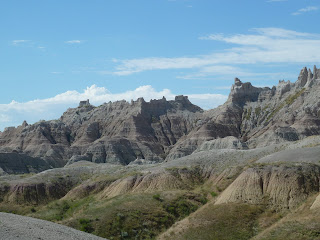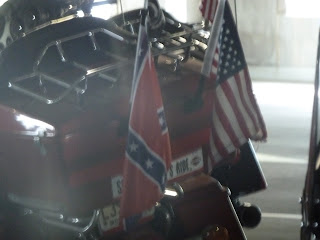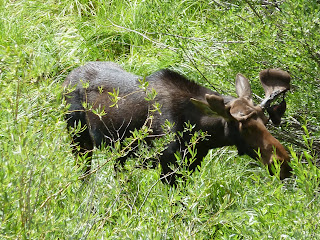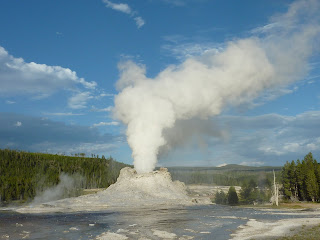Day 34: Monday, August 9, 2010Wind Cave National Park, Crazy Horse Memorial, Indian Art Museum of North America
Nebraska is pretty outrageously hot, my friends. We tried to pack up and hit the road as soon as we could, but when it is that stifling, you can't breathe and you just want to sit and melt. It was a struggle.

Instead of getting right up to brush our teeth after breakfast, Matthew and I just sat on the pavement in front of the van, gazing lazily at the front bumper of the car which was caked in dead crickets, around which dozens of flies were swarming. Auntie saw us and just cracked up. Without blinking, I told her, “We're in Nebraska. There's not much else to do here, other than to watch the flies.”

On our way out, we met a woman who curious about our backpack (why wouldn't she be?). It transpired that she was a librarian, so of course she and Auntie Cindy hit it off. It may sound naive, but I think until meeting her I had never really stopped to think about motivating kids to read in Nebraska before. The basic lack of motivation is arguably universal, but perhaps the resources are fewer and the incentives less strong in that part of the country than where I grew up. And yet reading is so integral to our lifestyle today, that those who cannot or will not are often marginalized. It is such a crucial skill that we really have no say over learning, nor any recollection of developing it.
We took our leave of Nebraska, the land of the crazy hissing bugs and katydids, sweltering heat and little shade, and headed into South Dakota to Wind Cave National Park. As predicted, the number and frequency of motorcycle sightings spiked dramatically upon crossing the border.

Wind Cave was quite possibly my favorite national park thus far—more points to the parks I had never heard of before! Although there is much evidence that the Native Americans knew of the cave, its first documented discovery was by two brothers, Tom and Jesse Bingham, who were out riding through a prairie when they heard a whistling sound. The whistling was the result of the wind blowing out of the cave opening, a mere 10” in diameter, because the air pressure inside the cave was higher than the atmospheric pressure of the air outside the cave. On any given day, the cave is said to either “breathe in” or “breathe out”. Today it was breathing out.Since the original opening of the cave was so small, a larger one was blasted to the side to allow tourists access, and it was through this entrance we entered the fabulous Wind Cave, trekking an amazing 210 feet (21 stories) underground in a continuous, interconnected cave.
Wind Cave was the first cave in the world to be named a national park, and the seventh national park in the United States, but it's not one that get a lot of coverage, a situation that I hope to rectify starting now.

You might think of a cave as dark and damp and cold, and if so, then you would be correct. But before you groan in disgust, let me tell you it was marvelous. I loved it. Wind Cave is beautifully and artfully lit in a simple fashion with fluorescent lights, that damage the cave less and attract less moisture.

The feature Wind Cave is most renowned for is boxwork, a rock formation that is the result of a layer of calcite seeping into the cracks of the limestone below it. Once the limestone eroded, the calcite remained, leaving a intricate grid of thin rock on the ceilings and walls of the cave. This formation is exceedingly rare, such that 95-97% of the world's known boxwork is housed in Wind Cave National Park in South Dakota.
Wind Cave also protects two other equally intricate cave formation known as cave popcorn and frostwork, but does not have any stalactites or stalagmites, as it is a dry cave.

After Wind Cave, we pulled into the Crazy Horse National Memorial, an independently-funded monument to the Native Americans a few miles from Mt. Rushmore. Like Rushmore, it features an enormous sculpture carved and exploded from a mountain-face; however, all of the faces of Rushmore could fit in the head of Crazy Horse himself, excluding his hair, his torso, and his horse.
Crazy Horse is a symbol to the Native Americans of freedom, pride, and unbridled energy. He was chosen by the Lakota elders to represent the Native American plight in the States. Most relevant for us, we learned that Crazy Horse was murdered by an American soldier under a flag of truce at Fort Robinson, Nebraska--the very land on which we happened to have spent the previous night.

The Crazy Horse Memorial also houses the Indian Art Museum of North America--an unrivaled collection of Native American artwork, tools, clothing, and toys--and the Native American Cultural Center. The Black Hills are sacred land to the Oglala Lakotas, the significance of which was recognized by the sculptor Korczak Ziolkowski, whose family of ten children still organizes the memorial.
As legend has it, a white man sneered and asked Crazy Horse, "Where are your lands now, Crazy Horse?" And the Lakota warrior pointed to the distance and cried the words that still ring today: "My lands are where my dead lie buried".

 The rest of the time we spent seeing Auntie Cindy's godmother, Aunt Lois; our Aunt Gloria and Uncle Denny in Duluth; Uncle Jeff and Aunt Elaine and their kids Esther and Micah; Uncle Michael and Aunt Colleen and their kids Emily, Alicia, and Jordan; Uncle Ron; Cousin Kelly; Cousin Kevin; Grandpa and Grandma Swanson; Aunt Kathy; and the Kellys. We went to an Irish Fair, an Indian pow wow, the Minnesota State Fair, and Canal Park. Among us, we rode on one of the five alpine coasters in the States, and went biking, swimming, and hiking. Auntie and I also toured Macalester College in St. Paul. The days have been packed but relaxed.
The rest of the time we spent seeing Auntie Cindy's godmother, Aunt Lois; our Aunt Gloria and Uncle Denny in Duluth; Uncle Jeff and Aunt Elaine and their kids Esther and Micah; Uncle Michael and Aunt Colleen and their kids Emily, Alicia, and Jordan; Uncle Ron; Cousin Kelly; Cousin Kevin; Grandpa and Grandma Swanson; Aunt Kathy; and the Kellys. We went to an Irish Fair, an Indian pow wow, the Minnesota State Fair, and Canal Park. Among us, we rode on one of the five alpine coasters in the States, and went biking, swimming, and hiking. Auntie and I also toured Macalester College in St. Paul. The days have been packed but relaxed.
 We depart the Twin Cities for Chicago in a few hours, via Wisconsin. Minnesota, it's been lovely!
We depart the Twin Cities for Chicago in a few hours, via Wisconsin. Minnesota, it's been lovely! 
















































